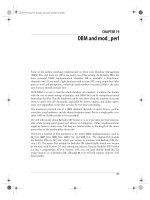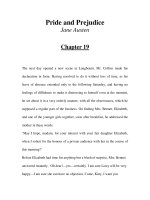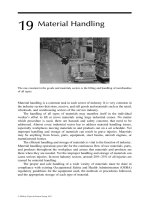Chapter 19 – taxes on consumption and wealth
Bạn đang xem bản rút gọn của tài liệu. Xem và tải ngay bản đầy đủ của tài liệu tại đây (274.84 KB, 39 trang )
Chapter 19 – Taxes on
Consumption and Wealth
Public Economics
1
Introduction
• There is substantial dissatisfaction with
the federal personal and corporate
income tax systems.
• One possibility is to adopt a consumption
tax whose base is actual consumption.
Another possibility is a tax on wealth,
whose base is accumulated saving.
2
Retail Sales Tax
• Several types on sales taxes levied on
wide variety of commodities:
– General sales tax impose the same tax rate
on the purchase of all commodities.
– Selective sales tax is levied at different rates
on the purchase of different commodities.
• Also known as excise tax or differential
commodity tax.
3
Retail Sales Tax
• Table 19.1 shows tax revenue collected
from various sales taxes.
• Federal government levies no general
sales tax, but does tax motor fuel,
alcoholic beverages, tobacco, and some
other commodities.
• Large majority of states have sales tax,
with rates between 2.9% and 7.25%.
4
Table 19.1
Retail Sales Tax
• Sales taxes generally take one of two
forms:
– A unit tax is a given amount for each unit
purchased (e.g., motor fuel tax that is a
certain number of cents per gallon of
gasoline).
– An ad valorem tax is computed as a
percentage of the value of the purchase.
6
Retail Sales Tax
• Rationalizations for a sales tax
– Administrative Considerations
• Collected at retail level, have to monitor fewer units.
Nonetheless, still difficult, and defining the tax base
somewhat arbitrary.
• Underground markets / smuggling
– Optimal Tax Considerations
• It can be shown that the income tax is not optimal,
differential commodity taxes can improve welfare.
• Inverse elasticity rule could guide the rate setting
7
Retail Sales Tax
• Rationalizations for a sales tax
– Other considerations
• Sin taxes
• Merit goods
8
Retail Sales Tax
• Efficiency and Distributional Implications
– Would the pattern of sales tax rates minimize
excess burden?
– Overall excess burden depends on both the
elasticities of each good and the degree of
substitutability or complementarity with other
goods.
– Equal tax rates is almost certainly not
efficient.
9
Retail Sales Tax
• Efficiency and Distributional Implications
– When viewed in a lifetime perspective (rather
than an annual perspective), general sales
taxes are somewhat progressive.
– More generally, however, statutory incidence
of sales tax is not the same as the economic
incidence.
10
Retail Sales Tax
• Efficiency and Distributional Implications
– Exempting goods that are consumed
intensively by the poor (such as food) can
make the after-tax distribution more equal,
but achieving equality this way is difficult.
• Many upper-income families still benefit
• Administrative complexity
11
Retail Sales Tax
• Some proposals for replacing income tax
with a national retail sales tax.
• Advantages include simplicity and
compliance.
• Rates would have to increase from the
current 3-7% range to about 35%.
Benefits from cheating would increase
greatly.
12
Retail Sales Tax
• National sales tax creates transitional issues
– Those who had accumulated wealth under the
existing income tax structure would suffer.
Accumulated wealth was taxed through the personal
income tax.
– Saved for future consumption, which is now more
expensive.
• Viewed in this light, such a tax is essentially a
one-time tax on wealth.
13
Value Added Tax
• Goods are produces in several stages
before becoming final goods.
• The value added at each stage of
production is the difference between the
firm’s sales and the purchased material
inputs used in production.
• Table 19.2 gives an illustration.
14
Table 19.2
Value Added Tax
• A value-added tax (VAT) is a percentage
tax on value added applied at each stage
of production.
• VAT is just an alternative method for
collecting a retail sales tax.
16
Value Added Tax
• Implementation issues
– How are durable investment assets treated?
• In Europe, consumption-type VAT excludes the
investment from the tax base.
– Collection procedure
• In Europe, invoice method is used. Each firm is liable
for taxes on entire sale, but can claim a credit on
previous taxes paid by firms upstream with appropriate
invoices. Provides incentive for producers to selfpolice against evasion.
17
Value Added Tax
• Implementation issues
– Rate structure
• In Europe, commodities are taxed
differentially (e.g., food and health are taxed
at low rates).
• Nonuniform taxation increases administrative
complexity, especially when firms produce
multiple outputs that are taxed differently.
18
Value Added Tax
• A VAT for the U.S?
– Desirability of the VAT can be determined
only if we know what tax it would replace,
how the revenues would be spent, and so
forth.
– Possible that the VAT might be used to sneak
by an increase in the size of the government
sector.
19
Hall-Rabushka Flat Tax
• Legal incidence of a retail sales tax and
the VAT falls onto business. Consumers
make no explicit payments to
government.
• Other proposals require personal
consumption taxes, and allow individuals
tax liabilities to depend on their personal
circumstances.
20
Hall-Rabushka Flat Tax
• Hall and Rabushka (H&R) plan a flat tax.
– Two tax collecting vehicles:
• A business tax
– Consumption-type VAT
– Firm also deducts payments to its workers
– Flat tax on the final amount
• Individual compensation tax
– Base is payments received for labor services
– No taxes on capital income
– Allow exemption, but no other deductions
21
Hall-Rabushka Flat Tax
• Why is this consumption tax?
– The business tax is essentially a VAT, which
is equivalent to a sales tax.
– The wage payments are taxed at the same
rate (19%) that is applied to businesses.
These were deducted on the business-side.
This simply changes the point of collection
for part of the tax.
22
Cash-Flow Tax
• Each household files a return reporting their
consumption expenditures during the year.
– Various exemptions and deductions can be taken.
– Tax bill from adjusted amount of consumption.
• How does one compute annual consumption?
– Cash-flow basis is difference between all cash
receipts and saving.
– Difficult recordkeeping
23
Efficiency and Fairness of
Personal Consumption Taxes
• Efficiency issues
– Using a life-cycle model, on the surface a
consumption tax does not create excess
burden as an income tax does.
• Income tax changes relative price of
consumption in the future versus today.
• This assumes labor supply is fixed, however.
A consumption tax does distort the rate at
which a person can trade off leisure versus
consumption.
24
Efficiency and Fairness of
Personal Consumption Taxes
• Equity Issues
– Progressiveness
• A personal consumption tax can be made as
progressive as desired with suitable
exemption levels
– Ability to pay
• Those who favor income tax argue that
potential (not actual) consumption is relevant.
25









